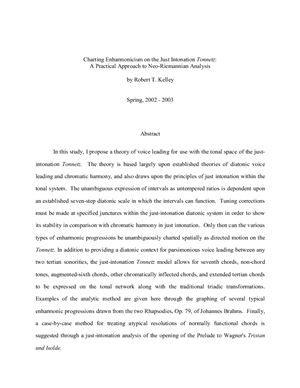2002, 50 pages
Abstract
In this study, I propose a theory of voice leading for use with the tonal space of the justintonation
Tonnetz. The theory is based largely upon established theories of diatonic voice
leading and chromatic harmony, and also draws upon the principles of just intonation within the
tonal system. The unambiguous expression of intervals as untempered ratios is dependent upon
an established seven-step diatonic scale in which the intervals can function. Tuning corrections
must be made at specified junctures within the just-intonation diatonic system in order to show
its stability in comparison with chromatic harmony in just intonation. Only then can the various
types of enharmonic progressions be unambiguously charted spatially as directed motion on the
Tonnetz. In addition to providing a diatonic context for parsimonious voice leading between any
two tertian sonorities, the just-intonation Tonnetz model allows for seventh chords, non-chord
tones, augmented-sixth chords, other chromatically inflected chords, and extended tertian chords
to be expressed on the tonal network along with the traditional triadic transformations.
Examples of the analytic method are given here through the graphing of several typical
enharmonic progressions drawn from the two Rhapsodies, Op. 79, of Johannes Brahms. Finally,
a case-by-case method for treating atypical resolutions of normally functional chords is
suggested through a just-intonation analysis of the opening of the Prelude to Wagner's Tristan
und Isolde.
Abstract
In this study, I propose a theory of voice leading for use with the tonal space of the justintonation
Tonnetz. The theory is based largely upon established theories of diatonic voice
leading and chromatic harmony, and also draws upon the principles of just intonation within the
tonal system. The unambiguous expression of intervals as untempered ratios is dependent upon
an established seven-step diatonic scale in which the intervals can function. Tuning corrections
must be made at specified junctures within the just-intonation diatonic system in order to show
its stability in comparison with chromatic harmony in just intonation. Only then can the various
types of enharmonic progressions be unambiguously charted spatially as directed motion on the
Tonnetz. In addition to providing a diatonic context for parsimonious voice leading between any
two tertian sonorities, the just-intonation Tonnetz model allows for seventh chords, non-chord
tones, augmented-sixth chords, other chromatically inflected chords, and extended tertian chords
to be expressed on the tonal network along with the traditional triadic transformations.
Examples of the analytic method are given here through the graphing of several typical
enharmonic progressions drawn from the two Rhapsodies, Op. 79, of Johannes Brahms. Finally,
a case-by-case method for treating atypical resolutions of normally functional chords is
suggested through a just-intonation analysis of the opening of the Prelude to Wagner's Tristan
und Isolde.

